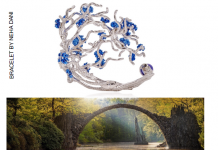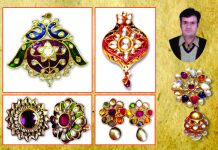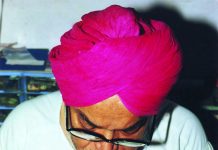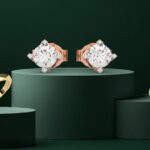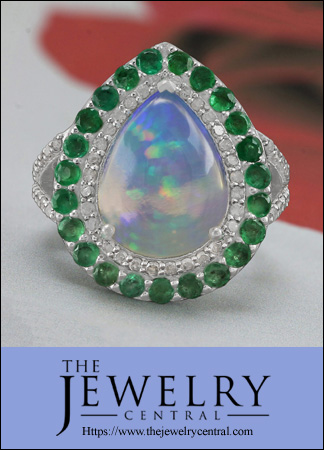 All of Nature’s splendour seems to be reflected in the manifold opulence of fine Opals: fire and lightnings, all the colours of the rainbow and the soft shine of far seas. Australia is the classical country of origin. Almost ninety-five per cent of all fine opals come from the dry and remote outback deserts.
All of Nature’s splendour seems to be reflected in the manifold opulence of fine Opals: fire and lightnings, all the colours of the rainbow and the soft shine of far seas. Australia is the classical country of origin. Almost ninety-five per cent of all fine opals come from the dry and remote outback deserts.
Numerous legends and tales surround this colourful gemstone, which can be traced back in its origins to a time long before our memory, to the ancient dream time of the Australian aborigines. It is reported in their legends that the creator came down to Earth on a rainbow, in order to bring the message of peace to all the humans. And at the very spot, where his foot touched the ground, the stones became alive and started sparkling in all the colours of the rainbow. That was the birth of the Opals.
 The group of fine Opals includes quite a number of wonderful gemstones, which share one characteristic: they shine and sparkle in a continually changing play of colours full of fantasy, which experts describe as “opalising”. Depending on the kind, place of occurrence, and colour of the main body, we differentiate Dark or Black Opal, White or Light Opal, Milk or Crystal Opal, Boulder Opal, Opal Matrix, Yowah Nuts from Queensland – the so-called “picture stones“, and also Mexican and Fire Opal. Opal variations are practically unlimited. They all show in their own special way that unique play of colours – except for Fire Opal, which due to its transparency, however, is nevertheless also considered a Fine Opal specimen. If Opals are lacking the typical play of colours, they are simply named “Common Opal”.
The group of fine Opals includes quite a number of wonderful gemstones, which share one characteristic: they shine and sparkle in a continually changing play of colours full of fantasy, which experts describe as “opalising”. Depending on the kind, place of occurrence, and colour of the main body, we differentiate Dark or Black Opal, White or Light Opal, Milk or Crystal Opal, Boulder Opal, Opal Matrix, Yowah Nuts from Queensland – the so-called “picture stones“, and also Mexican and Fire Opal. Opal variations are practically unlimited. They all show in their own special way that unique play of colours – except for Fire Opal, which due to its transparency, however, is nevertheless also considered a Fine Opal specimen. If Opals are lacking the typical play of colours, they are simply named “Common Opal”.
Upala, opallios or Opalus – fascination created by tiny spheres
The name Opal was probably derived from Sanskrit “upala“, meaning ”valuable stone“. This was probably the root for the Greek term “opallios”, which translates as “colour change”. In the days of Roman antiquity there existed a so-called “opalus”, or a “stone from several elements”. So the ancient Romans may already have had an inkling why the Opals show such a striking play of colours. But we will come to this later …
Pliny, the famous Roman author, called Opal a gemstone which combines the best possible characteristics of the most beautiful of gemstones: the fine sparkle of Almandine, the shining purple of Amethyst, the golden yellow of Topaz, and the deep blue of Sapphire, ”so that all colours shine and sparkle together in a beautiful combination“.
Up to the first half of the 19th century, Opals were relatively rare. But then their career boomed suddenly and made them one of the most popular gemstones, and the start of this development brought them to the gemstone cutters of the gemstone centre of Idar-Oberstein. In the era of Art Deco the Opals experienced their flourishing, with contemporary gemstone artists preferring them to all other stones because of their subdued charm, which in turn was excellently suited to be combined with enamel, another very popular material of those days.
Opal’s colour play emanates a very special attraction and fascination. But what causes this phenomenon? This question was impossible to answer for a very long time. Only when in the 1960s a team of Australian scientists analysed Opals with an electron microscope, it was discovered that small spheres from silica gel caused interference and refraction manifestations, which are responsible for the fantastic play of colours. The spheres, which are arranged in more or less compact structures, succeed in dissecting the light on its passage through the gemstone and turning it into all the colours of the rainbow, always new and always different.
Australia, classical Opal country
Australia is the classical Opal country and today is the worldwide most important supplier of Fine Opals. Almost 95 per cent of all Opals come from Australian mines. The remaining five per cent are mined in Mexico, and in Brazil’s north, also in the US states of Idaho and Nevada, but recently the stones have also been found in Ethiopia and in the West African country of Mali.
 The history of Australian Opal began actually millions of years ago, when parts of Australia were covered by a vast inland sea, and stone sediment was deposited along its shoreline. When the water masses flooded back, they flushed water containing silica into the resulting cavities and niches in the sedimentary rocks, and also the remains of plants and animals were deposited there. Slowly the silica stone transformed into Opal, for basically Opals are simply a combination of silica and water. Or, to be more precise: Opals are a gel from silica, with varying percentages of water.
The history of Australian Opal began actually millions of years ago, when parts of Australia were covered by a vast inland sea, and stone sediment was deposited along its shoreline. When the water masses flooded back, they flushed water containing silica into the resulting cavities and niches in the sedimentary rocks, and also the remains of plants and animals were deposited there. Slowly the silica stone transformed into Opal, for basically Opals are simply a combination of silica and water. Or, to be more precise: Opals are a gel from silica, with varying percentages of water.
In 1849 the first Opal blocks were accidentally found on an Australian cattle station called Tarravilla . the first Opal prospectors started in 1890 at White Cliff mining the Opal rocks. And even today the eyes of Opal lovers light up when somebody mentions places like White Cliffs, Lightning Ridge, Andamooka or Coober Peddy: for these are the legendary sites of the Australian Opal fields. The most famous one is probably Lightning Ridge, the place where mainly the coveted Black Opal is found. Andamooka, where Crystal Opal and Light Opal are brought to the light of day, cam boast to be the place where the probably largest Opal was found, with a weight of 6 ,843 kilograms, the “Andamooka Desert Flame”. Coober Peddy, by the way, is a word from Aborigine language meaning „white man in a hole“. This clearly describes how Opal was in fact mined: many Opal prospectors made their home in deep holes or caves in the ground, to protect themselves from the burning heat of daytime and from the icy winds of night time. Usually they worked only with tolls such as pick and shovel. Buckets full of soil, hopefully containing Opal rocks, were pulled up out of the depths of 5 to 40 m deep shafts by hand, for this is the depth of the Opal containing crevices and cavities, which are also mined nowadays.
Being an Opal prospector is still not an easy job, although today of course there are some technical means available, such as trucks or conveyor belts. And still the hope to make the find of a lifetime which will let you live happily ever after attracts many men and women to come to the hot and dusty Australian outback.
About cabochons, doublets and triplets
 In order to best bring out the play of colour in a Fine Opal, the stones are cut and polished to round or oval cabochons, or any other softly domed shape , depending on the raw material. Only the best qualities of Fire Opal, however, are suited to faceting. The Opal cutter will first of all carefully remove any impurities using a diamond cutting wheel, before working out the rough basic shape. The comes the fine cutting, the finishing with sandpaper and then the final polishing with a wet leather wheel.
In order to best bring out the play of colour in a Fine Opal, the stones are cut and polished to round or oval cabochons, or any other softly domed shape , depending on the raw material. Only the best qualities of Fire Opal, however, are suited to faceting. The Opal cutter will first of all carefully remove any impurities using a diamond cutting wheel, before working out the rough basic shape. The comes the fine cutting, the finishing with sandpaper and then the final polishing with a wet leather wheel.
Opal is often found as flat lenses, or thin layers, bigger pieces are rather rare. If you leave a thin but supporting layer of the harder mother rock, you will receive a pre-stage of the Opal-doublets which are frequently used today for mass produced jewellery. These are gemstone combinations consisting of a surface from millimetre-thin Opal plates, which have been mounted on Onyx, Obsidian, artificial black glass, or Potch-Opal. Triplets have been developed from this design, here the Opal layer receives an additional cover from Rock Crystal, Plastic, Hard Glass or Lead Glass for protection.
Opal love to be worn on the skin
Due to the differing percentage of water, Opals may easily become brittle. They always contain water – usually between 2 and 6 per cent, but sometimes even more. Thus if stored too dry or exposed to heat over a longer period of time, Opals will show fissures and the play of colour will become paler. Therefore, Opal jewellery should be worn as often as possible, for then the gemstone will receive the needed humidity from the air and from the skin of its wearer.
Opals are not very hard: they only achieve 5.5 to 6 on the Mohs’ scale. Therefore they appreciate a protective setting. In earlier days Opal’s sensitive surface was often oiled, but today also sealing them with colourless artificial resin has become quite popular.
From Harlequin to Peacock: Opal experts lingo
When Opal experts talk about “harlequin”, “church windows” or “needle fire”, do not be surprised. They are probably discussing Opals. The play of colour in this stone is described with many imaginative terms for various structures and phenomena, like, for example, “flame opal”, “lightning and peacock opal”, or the above named “harlequin” and “church window”.
Opal’s value is not only determined by the body colour, transparency and factors based on place of occurrence. (Body colour refers to the basic colour of the gemstone, which can be black, dark or light and coloured). It is also important if the stone is transparent, translucent or opaque. And the opalizing effect may also influence the transparency.
Black Opal or Opal with a dark grey body shows the most brilliant play of colours imaginable. Crystal opal, which comes immediately after Black Opal in the hit list, should be more transparent with a deep play of colours. White or milky Opals show more diffuse colours and are the least expensive Opals. The occurrence-specific characteristics include, for instance, denominations such as “Black Opal from Lightning Ridge” (we are talking absolute top luxury here) or “Mexican Fire Opal”.
The most important criterion for determining the price of an Opal, however, is the play of colour, the colours as such and their pattern. If the colour red appears when looking through the stone, all the other colours will appear also. For evaluating Opals the thickness of the Opal layer is considered, the beauty of the patterning, the cut, weight and finish. Finally the total impression will be decisive, and of course offer and demand will determine ho much you will have to pay for “your” Opal. If you are interested in a really valuable specimen, get an Opal expert to advise you, because it takes a real expert to know about the many criteria which determine the price.
Opals and emotions
For ages people have been believing in the healing power of Opal. It is reported to be able to solve depressions and to help its wearer find the true and real love. Opals are supposed to further enhance the positive characteristics for people born under the zodiac sign of Cancer. Black Opal is recommended to those born under Scorpio, and Boulder Opal is the lucky stone for Aries.
The fantastic colour play of Opal reflects changing emotions and moods of people. Fire and water, the sparkling images of Boulder Opal, the vivid light flashes of Black Opal or the soft shine of Milk Opal – striking contrasts characterise the colourful world of this fascinating gemstone. Maybe this is the reason why it depends on our daily mood which Opal we prefer. Opals are like human emotions: you always experience them different and anew.

